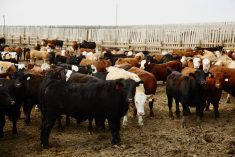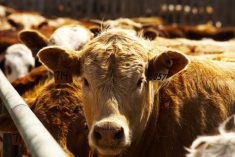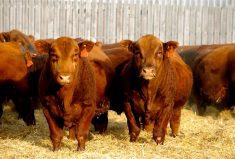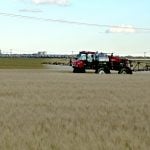While any type of beef operation can benefit from establishing consistent animal health protocols, this is especially evident when caring for the health of thousands of feeder calves at a time.

Kristen Hunter, feedlot manager at Buffalo Plains Cattle Co. at Bethune, Sask., knows this firsthand. Hunter, a veterinary technician who has worked in feedlot and animal health positions for 25 years, spoke about her experience implementing animal health protocols at the 2018 Western Canada Feedlot Management School in Regina. Since starting at Buffalo Plains in 2011, she’s watched the feedlot go through a major expansion, increasing its capacity from 3,500 to 25,000 head. The feedlot also has a 1,000-head cow-calf herd.
For Hunter, building a vet-client relationship is a primary consideration when creating health protocols. “It absolutely takes time, respect and trust to establish,” she said. A vet’s on-site visits play a major role in this relationship, and the regularity of these visits depends on your herd. “For the feedlot right now, my herd health vet shows up annually. My nutritional vet shows up probably every eight weeks or so.”
Read Also
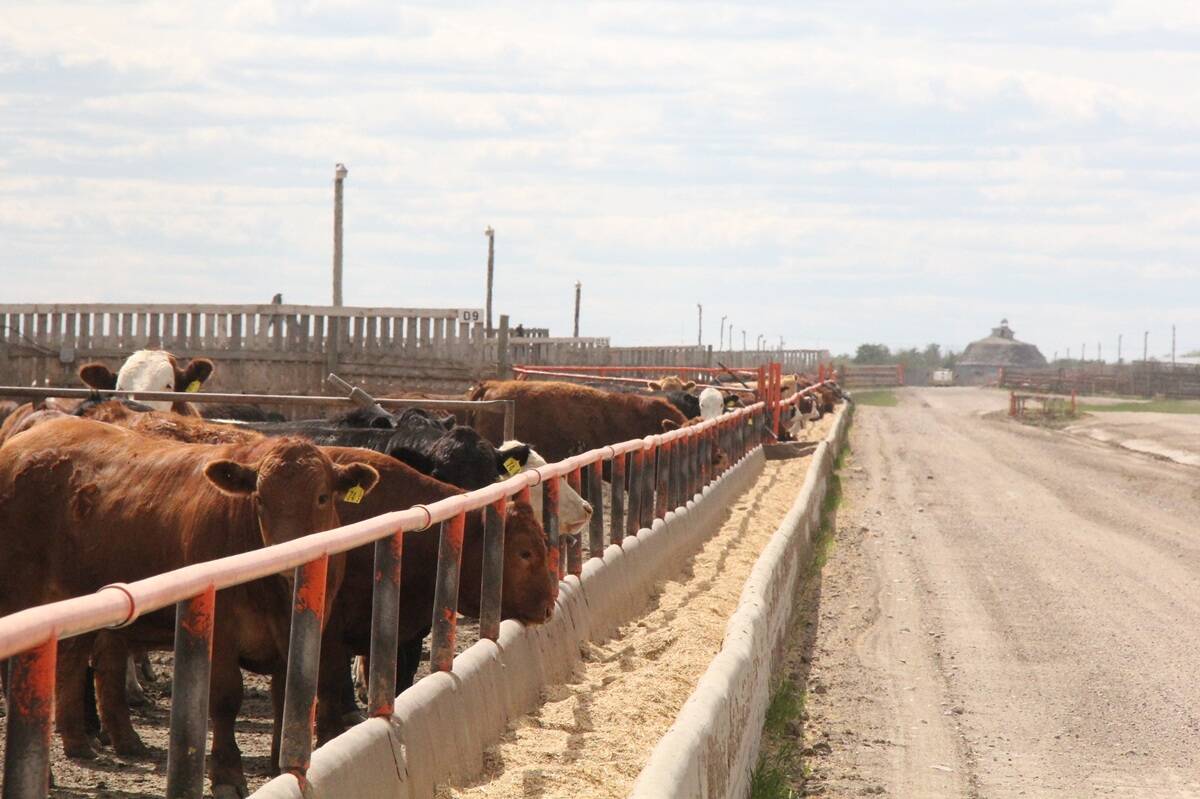
Unwinding the fibre in feedlot cattle diets
Research into how barley rolling method and undigestible NDF levels affect animal performance and digestive health in finishing diets
Communication is key to this relationship. Hunter often communicates with her vet through TeamViewer, an online conferencing program, and she relies on the annual report cards he creates using data from the feedlot. “That is a tool I use to help establish protocols. The only way I know if I’m moving forward is by all the information I get back from him, so it’s absolutely vital.”
It’s important to ask questions and sometimes challenge your vet’s suggestions to learn more and make the best decisions for your herd together. “I challenge them on a regular basis. It’s my job,” she said. “As a producer, you have the final say on that protocol.”
Cost is another aspect to consider. “Anything that we can do to increase that margin and make a little profit is critical,” said Hunter. This can become a challenge when implementing protocols. “You want to cut costs, but you also want to be efficient. There’s a fine line there. We can’t afford to waste or overuse drugs.”
Overall, the needs of your herd will determine your protocols, and the best way to understand these needs is to know your cattle well. “To establish your protocols, you need a herd history, and that takes years,” she stated. “That’s not something that’s going to happen overnight.”
Start at the source
When establishing health protocols, Hunter advised beginning with the breeding female. “The best protocols start right from the source. She’s your foundation,” she said. “You need to establish a vaccination protocol that works for your herd.” Consider herd size, vaccination timing and frequency, and the type of vaccine when planning this. “You do want to have a defined, consistent vaccination handling protocol all the way from your cows to your calves, from induction to finish.”
For Hunter, proper nutrition is vital to animal health. “I’m told I feed them too much and I’m spending too much money on feeding the cows,” she stated. Based on the numbers she presented, however, her strategy has paid off. “My calving rate this last year, overall with both cows and calves, was 97 per cent.”
These positive results carried over to the pregnancy rates, with 85 per cent of heifers pregnant after 31 days of exposure. Cows were exposed for 45 days, and they also had an 85 per cent pregnancy rate, but Hunter noted that five per cent of this total were bred culls.
When creating protocols for calves, Hunter mentioned the importance of minimizing stress through processing methods and using pain relievers. “Not only is it becoming more important for the calves, it’s becoming more important for the consumer,” she said.
Everyday use of health protocols
Hunter outlined some of the different protocols used at Buffalo Plains, starting with guidelines for new feeder calves. “On arrival, all our animals we classify as ultra-high risk, so they get a blanket protocol,” she explained. As the goal is to minimize stress, they use a bud box in the processing system. “It’s the first step for the animal’s stay at the feedlot,” she said. “Their first experience is pleasant, and each time you run them through it just gets easier and easier, and by the second or third time, they’re doing it on their own.”
She keeps an eye on nutrition from the beginning. “Starting the early foundation for your feedlot cattle continues all the way through that feeding period,” she said. “All the best treatment and vaccination protocols are compromised if they’re not given that proper feed.”
Upon arrival, calves are given Draxxin. “My first drug after that on a fresh pull is Excede (Sterile Suspension),” said Hunter. Calves from their own herd are also given Draxxin when brought in to the feedlot, but not prior to that. This strategy is for peace of mind. “It helps me sleep at night. I know they’re on-ranch calves, but with all the stuff that’s out there, I want to know that they’re having the best start that they can,” she explained. “For treating something that’s out on pasture, I’ll use typically Resflor or something like that.”
There are specific protocols for “stale” calves (left behind at an auction market), calves compromised in rollovers and particularly small calves that come in at around 250 pounds. “How they are handled in the first 24 hours is critical. You want to process these calves promptly,” she said. “They’re put in a pen with fresh feed, water and bedding as soon as possible.” There are also protocols specific to the age of the animal and to use during extreme weather conditions.
In order to put these into practice, employees must have the necessary knowledge. “They have to have an eye for cattle,” said Hunter. “Checking cattle is hard to teach. It really is. You want to look for those early, subtle signs. Anybody can pull the obvious late ones.”
Pen riders need to know the protocols and use their best judgment. “I absolutely want these guys to use their discretion and common sense,” she said. “Your protocol is your guideline. It’s not written in stone. They have to think and assess that animal sometimes on an individual basis.”
Using information she collected throughout her feedlot career, Hunter created a treatment protocol booklet for Buffalo Plains, outlining common feedlot diseases and how to treat them, which she gives to each new pen rider. To ensure successful communication, she holds regular meetings with her pen riders to ensure they all understand the protocols and discuss any issues with certain pens. Flow of communication also needs to extend between the processors and pen riders.
Challenges
One of the challenges in implementing health protocols that Hunter has encountered is employees with less experience around cattle. “We need to teach them those proper skills,” she said. “We do the handbooks, I send them with my seasoned people, we have these meetings. We’re trying to get everybody on the same page.”
Flexibility can also be a challenge, especially when assessing individual cases. “For me, the thermometer is a guideline,” she said. “This is where the common sense and the discretion falls to the cowboy. I need these guys to go out there and assess the cattle and say, yes, I know he’s not temping, but to me when he’s already 102 and looks that bad, he’s on his way down.”
For example, Hunter stressed individual discretion when speaking about the timing of a first pull after giving Draxxin on arrival, as some believe it’s best not to pull for seven to 10 days. “I can’t do that. When we get cattle coming from every auction mart, you don’t know where they’ve been,” she said. “I’m going to say two, three days, they need that opportunity to get in and settled, but if day five, day six, you’ve got a tough calf, I’m not waiting. The animal has to be assessed.”
Another challenge that Hunter has noticed is that new pen riders are often inclined to pull more calves. This can become a problem when the focus is on numbers instead of properly treating calves. She recalled a pen rider who constantly pulled numerous calves because he was told that a certain percentage had to be pulled from each pen. “Those are extremely costly attitudes,” she stated. “I’ve never pulled an animal with the mentality of ‘oh well, it gets treated anyway.’
“The protocol is set up so if it temps, it gets this drug. If it doesn’t temp, it gets this drug. If you’re pulling an animal obviously something catches your eye, so you’re pulling it for a reason, so I don’t like sending it home without doing something.”
She stressed the importance of assessing cattle “before, during and after being pulled.” Because the pen riders don’t always do their own treatments, Hunter requires that they keep a list of the animals pulled and reasons for pulling, which they give to whoever treats the calves. From there, the processor is expected to assess the animal and use the corresponding protocol.
Over the course of her feedlot career, Hunter believes that a number of advancements in animal health have benefited beef producers. One such area is the types of drugs available. Early in her career, penicillin was used widely for a variety of ailments, but has been used less often in recent years. “One of the biggest assets to the industry has been access to a bigger basket of these longer-acting drugs,” she noted.
Another area is research. “I think today we have a better understanding of these diseases. We have a more specific diagnosis. For example, when I first started my feedlot career, everything was pneumonia,” she recalled. Now, these cases get a more specific diagnosis, and they can narrow in on the specific type of pneumonia. “Personally, I don’t think the diseases and health issues have changed over the last few years. I just think we’ve got better research and understanding on the problem areas of these health issues.”





